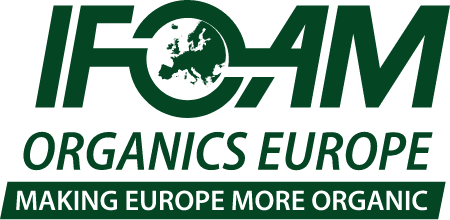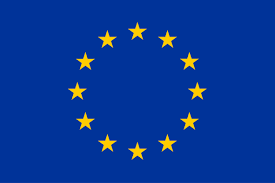
Biodiversity, soil, and water
Producing food while preserving our natural resources
Water pollution, desertification, biodiversity loss and soil erosion are a result of today’s industrial agricultural system. Organic farming helps reversing and mitigating these effects. Its practices create humus-rich top-soils, restore diversity above and below ground, retain water and contribute to solutions to water pollution. On average, organic farms host 34% more biodiversity than conventional ones.

Biodiversity
By closing nutrient cycles and prohibiting the use of synthetic pesticides and fertilizers, organic farming avoids unwanted negative effects on water, soil, and biodiversity. As a way of pest and disease management, organic farms create multifunctional landscapes rich in cultivated crop types providing a wildlife habitat for beneficial organisms in and around production areas.
Organic farm landscapes offer many benefits. On average, they are 50% more abundant with wildlife, hosting up to 34% more species on average on and around the farm. This includes almost 50% more pollinator species and 75% more plant species as well as more resilient systems.
Organic farming is a viable option to reduce agricultural intensity while at the same time fulfilling biodiversity protection goals. Farmland biodiversity also provides many ecosystem services that in turn are important for agricultural production itself, such as pollination, pest control and nutrient cycling.
The review of scientific literature on the benefits of organic farming for biodiversity, Biodiversity and organic farming – Policy options, commissioned by IFOAM Organics Europe, confirms these statements and analyses the positive impact of organic practices in detail.
The multiple benefits of organic farming for climate and biodiversity, such as increased carbon sequestration in soils, 30% more biodiversity on organic farms and increased resilience of the farming system can be further explored in the IFOAM Organics Europe document on organic agriculture and its environmental benefits.
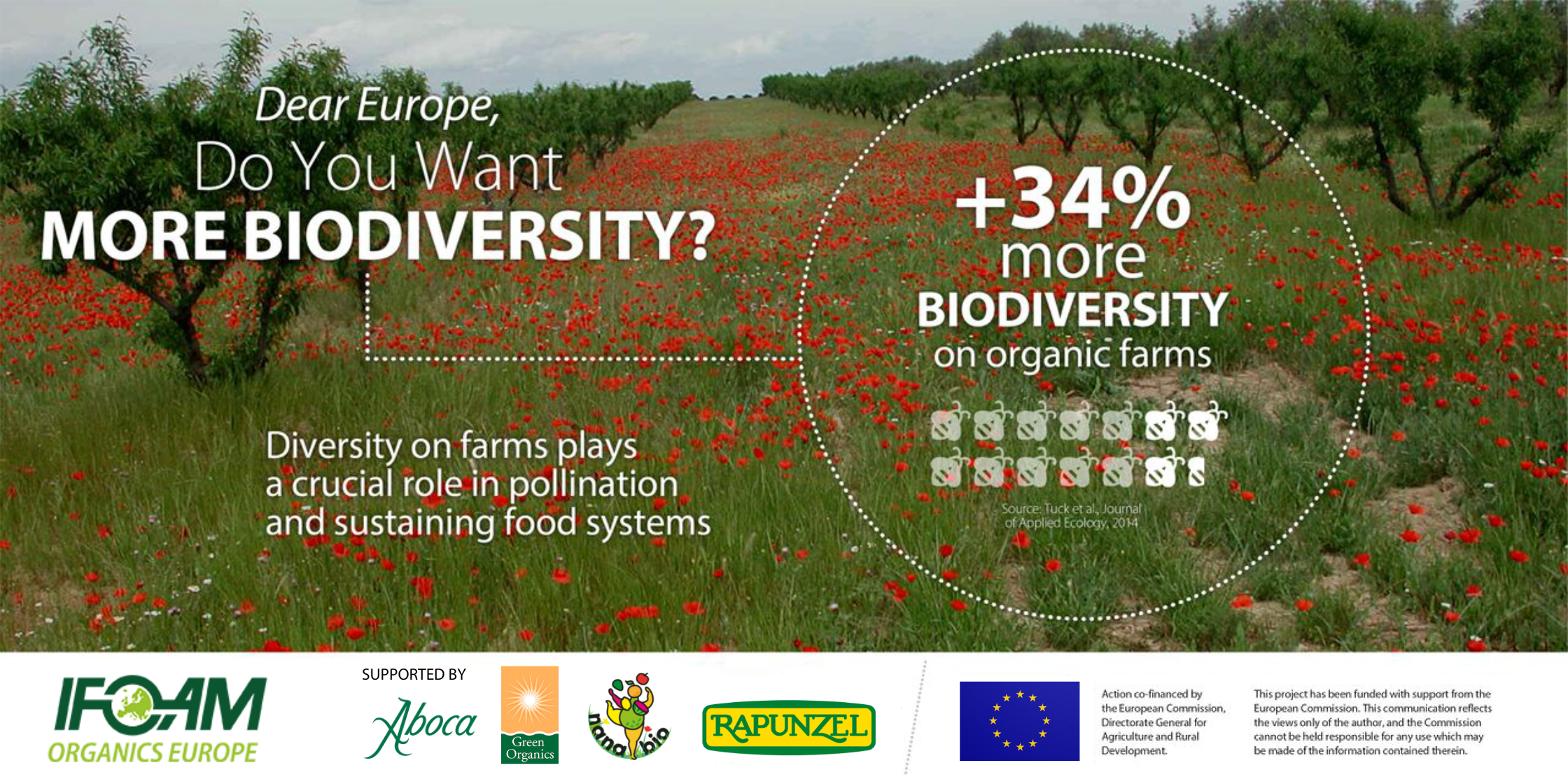
Soil
A healthy soil and high biodiversity are at the core of successful organic farming, rather than dependency on external inputs. Organically managed soils have, on average, 16 cm more top-soil, higher levels of soil organic matter (SOM), and an increased ability to sequester and store carbon.
Unsustainable land management practices, on the other hand, erode soil, deplete it of soil nutrients and, instead of sequestering it, release CO2 into the atmosphere.

Water
Industrial agriculture relies heavily on synthetic pesticides and mineral fertilizers. This has proven to be unsustainable in many ways. Overuse of irrigation also depletes usable water resources by over-pumping groundwater to an extent that exceeds the earth’s ability to replenish.
Ongoing water pollution through using synthetic pesticides and fertilisers reduces its quality for human consumption and creates so called dead zones in fresh and marine water bodies. Organic farms leach 40-64% less nitrogen, sustaining ecosystems and public health.
Organic farms’ water-infiltration rate is better than that of conventional farms, resulting in a 30% reduction of peak-flooding.
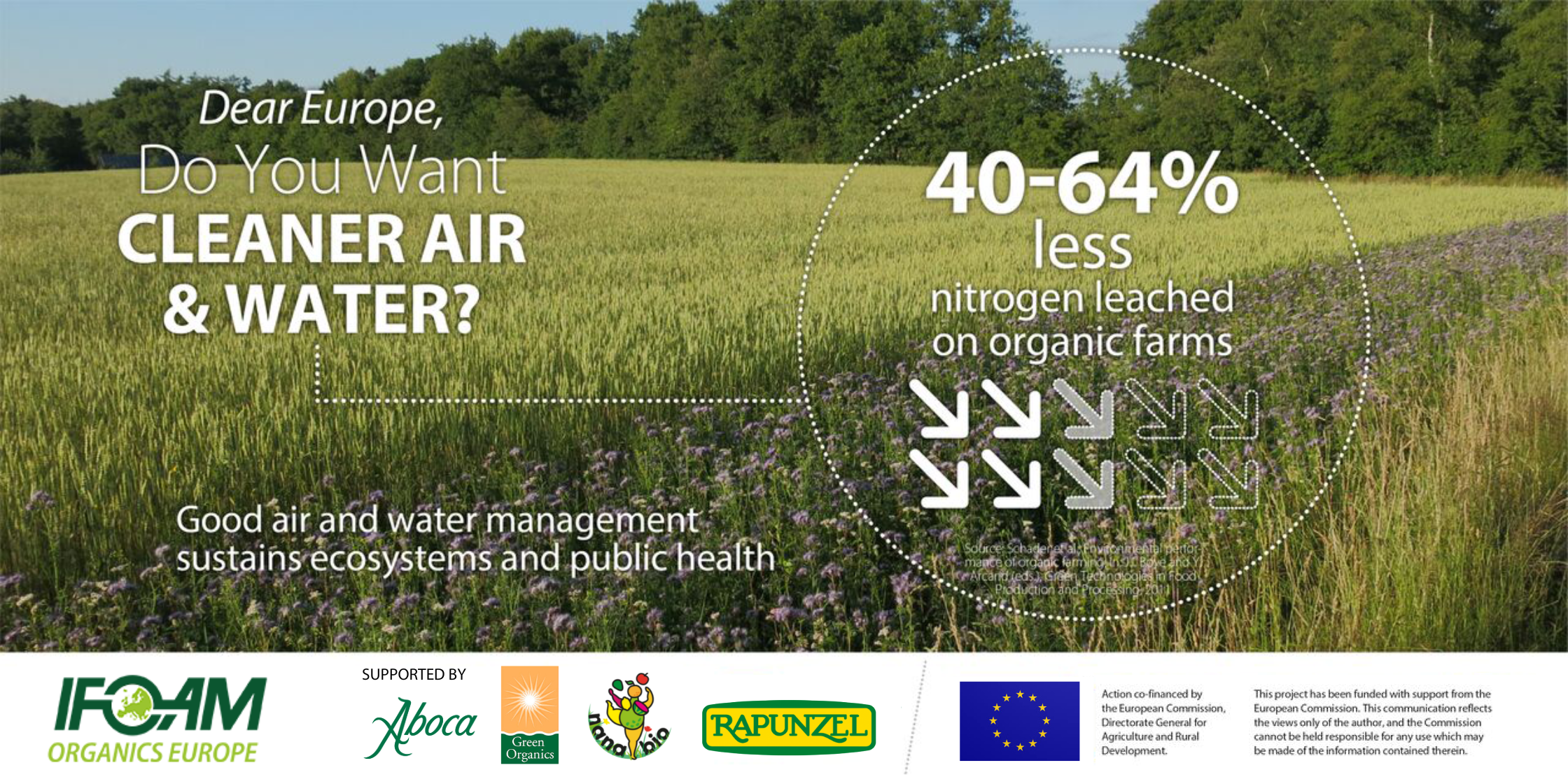
IFOAM Organics Europe…
- Advocates for including organic farming as a solution for issues on water, soil, and biodiversity in EU policies;
- Established a task force on climate change and biodiversity to identify how organic food and farming can further improve its contribution to protecting our natural resources;
- Plays a key role in EU research projects looking into continuously improving organics;
- Collected messages, arguments, and visuals on organic and biodiversity for its members (you need to be a member to access these, contact [email protected] for access rights and information about membership).

Find a higher quality version of this infographic, as well as FR, CZ and UA versions, in our library.
Sources
- Land‐use intensity and the effects of organic farming on biodiversity: a hierarchical meta‐analysis, Tuck et al. Journal of Applied Ecology, 2014
- Environmental Impact of Different Agricultural Management Practices: Conventional vs. Organic Agriculture, Gomerio et al, Critical Reviews in Plant Sciences, 2011
- Environmental performance of organic farming, Schader et al, in J.J. Boye and Y. Arcand (Eds.), Green Technologies in Food Productions and Processing, 2011
Ongoing processes
Biodiversity
Bringing nature back into our lives: EU Biodiversity Strategy for 2030 aims to recover Europe’s biodiversity by 2030. To do this, on agricultural land, it states that 25% of the EU’s agricultural land should be farmed organically. One of the key elements of the Biodiversity Strategy will be a proposal for legally binding nature restoration targets.
Soil
The Proposal Soil Framework directive (COM(2006) 620 was withdrawn in 2014, and the EU still lacks a comprehensive soil protection policy. The newly published Farm to Fork and Biodiversity strategies and the proposal for a new CAP contain measures that could potentially trigger actions to protect European soils. In November 2021 the Commission published the EU Soil Strategy for 2030 as one of the EU Biodiversity Strategy’s commitments. The Soil Strategy addresses the importance of healthy soils for climate change mitigation and adaptation, biodiversity, ecosystem services, food production and the economy. By 2023, the Commission is planning to table a legislative proposal on soil health to reach the objectives of the Soil Strategy and achieve good soil health across the EU by 2050 (as announced in the strategy).
Water
The Water Framework Directive (2000/60/EC) establishes a framework for the protection of inland surface waters, transitional waters, coastal waters, and groundwater. Among others, it promotes sustainable water use based on a long-term protection of available water resources and contributes to mitigating the effects of floods and droughts. The first management cycle ended in 2015 and showed mixed results. The second cycle ended in 2021. The third management cycle will end in 2027.
Legislative background
Biodiversity
- The EU Biodiversity Strategy for 2030 – Bringing nature back into our lives (COM/2020/380) aims at protecting nature and reversing ecosystem degradation. The strategy includes different actions to be delivered by 2030, such as the implementation of EU’s legally binding nature restoration targets. The European Commission’s proposal for a Nature Restoration Law is expected to be published in March 2022;
- The EU Pollinators Initiative (COM/2018/395) adopted in June 2018 is the first-ever EU initiative on wild pollinators and aims to address the decline of pollinators in the EU and contribute to global conservation efforts. It sets the framework for an integrated approach to the problem and a more effective use of existing tools and policies. In May 2021, the Commission published a report on progress in the implementation of the Initiative. Based on this, and further stakeholder consultation, the Commission will consider the scope for revising the EU Pollinators Initiative.
Soil
- The Commission’s Zero Pollution Action Plan for Air, Water and Soil (COM/2021/400) provides a vision for 2050 and key targets for 2030 to reduce pollution levels and improve air, water and soil quality;
- The EU Soil Strategy 2030 (COM/2021/699) aims at improving the status of European soils and foresees a legislative proposal on soil health tabled by the European Commission by 2023;
- The Proposal for the Soil Framework Directive (COM(2006) 620) was withdrawn in 2014.
Water
- The Commission’s Zero Pollution Action Plan for Air, Water and Soil (COM(2021) 400) provides a vision for 2050 and key targets for 2030 to reduce pollution levels and improve air, water and soil quality;
- The Environmental Quality Standards Directive (2008/105/EC) lays down environmental quality standards (EQS) for priority substances and certain other pollutants with the aim of achieving good surface water chemical status;
- The Water Framework Directive (2000/60/EC) establishes a framework to reach and maintain good water quality for all European waters;
- The Groundwater Directive (2006/118/EC) establishes a regime setting groundwater quality standards and introduces measures to prevent or limit inputs of pollutants into groundwater.
Soil is a valuable, non-renewable, resource of global importance. Human activities have long-lasting damaging and detrimental effects on this life-supporting structure. The European Commission took a first step to a coordinated approach to protect this resource in 2006, but the proposed EU Directive for the protection of soil was never adopted due to a blocking minority of Member States in the European Council. In the recently published Soil Strategy, the European Commission announced to propose a Soil Health Law in 2023.
IFOAM Organics Europe calls for more action, in particular through the Common Agricultural Policy (CAP), to:
- Minimise erosion,
- Stop salinization,
- Limit surface sealing and protect valuable farmland,
- Set maximum levels for soil contaminants,
- Maintain or enhance soil biodiversity,
- Limit compaction,
- Impose restrictions on damaging forms of land use.
BIOFRUITNET

BIOFRUITNET will strengthen the competitiveness of European organic fruit production through strong knowledge networks;
LIVESEEDING

LIVESEEDING will contribute to the upscaling of diversified organic seed production and strengthen the organic seed sector, informed by market demands;
INTERCROPVALUES

InterCropValuES aims to exploit the benefits of intercropping. It will create a better understanding of the functioning of intercropping systems and make a detailed analysis of lock-ins and levers for intercropping at the value chain level. It will identify credible solutions that can be adopted by farmers and value chain actors.
EU-FARMBOOK
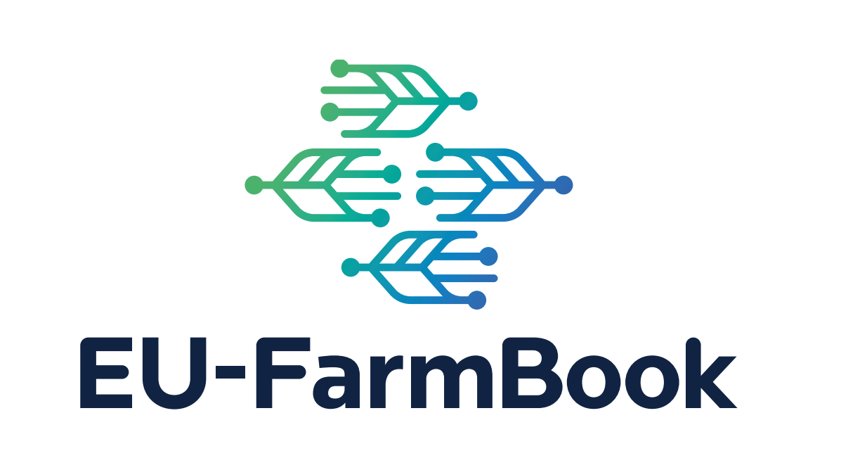
EU-FarmBook will support agricultural knowledge exchange by developing and maintaining an easily accessible EU-wide digital platform for practitioners in agriculture, forestry, and other rural sectors;
RELACS
Organic farmers adhere to high standards in producing quality food while protecting the environment and climate. To ensure organic farming keeps meeting its ambitious objectives it needs to improve continuously. The ‘Replacement of Contentious Inputs in Organic Farming Systems’ (RELACS) project will foster development and adoption of cost-efficient and environmentally safe tools and technologies to make this a reality. RELACS will investigate:
- Reducing copper and mineral oil use in plant protection,
- Identifying sustainable sources for plant nutrition, and
- Providing solutions to support livestock health and welfare.
Documents
- Policy brief explaining organic’s approach to inputs (RELACS project)
- Practice abstracts providing practical recommendations to implement the alternatives to contentious inputs developed by the RELACS project
- News updates from the RELACS project
Financial supporters
SOLMACC – Organic farmers countering climate change
The SOLMACC (Strategies for organic and low-input farming to mitigate and adapt to climate change) project demonstrated that farming can be climate-friendly by applying a combination of optimised organic farming practices. It promoted wider adoption of innovative practices that can contribute to reaching the EU’s climate change mitigation and adaptation objectives in the food and farming sector. Across Europe, farmers on 12 demonstration farms adjusted their agriculture techniques under close scientific monitoring and supervision over the course of five years.
Results
See how agroforestry, optimised tillage, optimised crops rotation and optimised nutrient management improved farms’ adaptation capacity. You can also read a summary of the SOLMACC project in the Layman’s report.
Are you a policymaker? You might want to read the policy recommendations: Increasing climate change mitigation and adaptation of the agriculture and food sector.
Watch the videos
Documents
- Leaflet
- Summary and results
- Policy recommendations
- Practical manual for climate-friendly practices: Part 1 and Part 2 (available in other languages on SOLMACC’s website)
Financial supporters
SOLMACC was supported by
Practices that increase Soil Organic Matter (SOM) and promote soil biological activity, with benefits for soil structure and water management, include:
- Multi-stage crop rotations: sequential cultivation of different types of crops to improve soil fertility and nutrient efficiency;
- Return of organic matter to the soil in the form of animal manure, compost or crop residues;
- Year-round soil coverage with inter-tillage (tillage between rows of crop plants), undersown crops or perennial forage;
- No use of harmful synthetic pesticides;
- At a processing level modern cleaning equipment and reusing water for pre-cleaning can contribute to save water in general.
Practices that maintain or increase overall biodiversity are:
- Usage of increased number of cultivated crop types;
- Growing indigenous plant varieties and raising animal breeds adapted to local conditions;
- Employment of mixed plant and animal farms, that also encourage nutrient cycling;
- Creation of green infrastructure, like hedges, fallows, beetle banks, meadows, and waters to attract birds, mammals, and insects for pest control;
- Soil quality management;
- Intercropping: growing two or more crops together at the same space for a part of or the whole growing season;
- Mechanical weeding.
Industrial farming contributes to the degradation of soils, the depletion of ecosystems and the misuse of antibiotics. The Pharmacy-Pasture project turns this trend around and offers livestock farmers the opportunity to sustainably fertilise their soils, restore ecosystems and ensure healthy ruminants. Read more about this initiative on euorganic2030.bio.
Organic fruit growers often suffer economic losses due to insect damages. Functional agrobiodiversity (FAB) can reduce pest damage and pesticide use in organic apple orchards. One exemplary measure is the use of flower strips, an easy, attractive, fast technique to improve functional biodiversity in cropping systems by maintaining beneficial insects in the crop. The EcoOrchard project (2014-2018) was launched to improve our understanding of flower strips behaviour in European orchards, and their effect on apple pests. For more information about this initiative, visit euorganic2030.bio.

The work of IFOAM Organics Europe on this topic is co-financed by the LIFE programme of the European Union, under the Climate, Infrastructure and Environment Executive Agency (CINEA). This page only reflects the views of the authors and its sole responsibility lies with IFOAM Organics Europe. The CINEA is not responsible for any use that may be made of the information provided.

